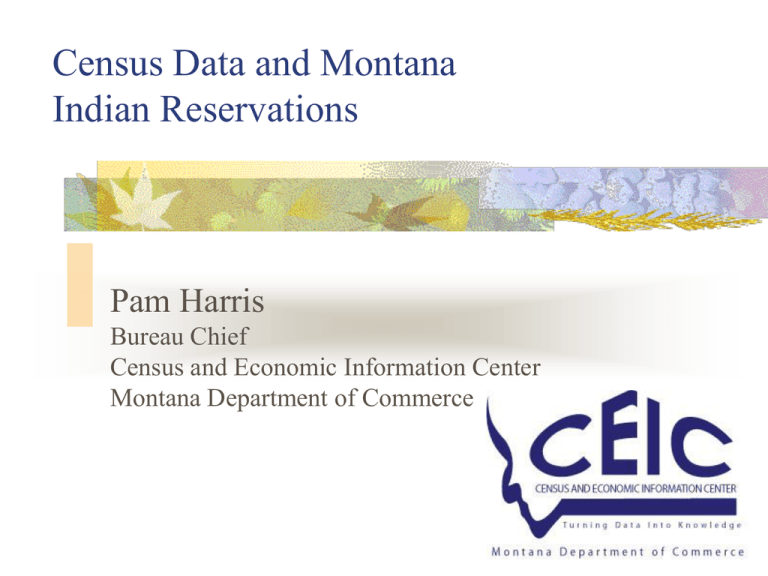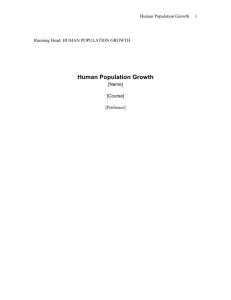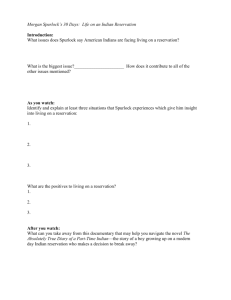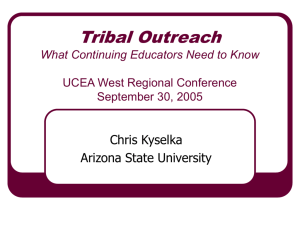Census Data and Montana Indian Reservations
advertisement

Census Data and Montana Indian Reservations Pam Harris Bureau Chief Census and Economic Information Center Montana Department of Commerce 1 CEIC – Who We Are Partnership with U.S. Dept. of Commerce, Census Bureau and Bureau of Economic Analysis to disseminate Montana data collected by federal agencies Cvs.C staff provide demographic and economic data and analysis, GIS support, technical assistance and training. 2 Assist Montana businesses, communities schools, and all government agencies to access and use this information for decision-making. Why Census Data? 3 Census data is unique Only source for small area data (reservation, cities/towns, tribal census tracts, etc.) Only source which shows characteristics for the population such as age, race, gender, educational attainment, income, labor force, types of households, etc. Census results are used to distribute almost $200 billion annually in federal, state, local, and tribal funds Examples of American Indian Federal Programs Relying on Census Data 4 Workforce Investment Program Community Development Block Grants (CDBG) Supplemental Food Program for Women, Infants and Children (WIC) Temporary Assistance to Needy Families Low Income Energy Assistance How can data help? 5 Census data helps tribal planners evaluate conditions on their reservations and in their communities. Tribal governments, states, cities, federal agencies, and businesses all need current information to make critical decisions. Data can help decide what services are needed and how to distribute funding for housing, economic development, health care, and other programs that benefit veterans, children, families, the elderly and the society as a whole. Census data is an important tool for tribal government decisionmaking and could result in improved utility services, new housing, job training, better school facilities, or a new health clinic to benefit you, your family, your community or reservation. More current data coming.. 6 American Community Survey (ACS) will replace the decennial census long form questionnaire producing the socio-economic data every year instead of every 10 years. Example – Workforce Investment Act of 1998 requires information about American Indian and Alaska Native households to support training and employment activities. ACS will provide this critically important information. ACS has been endorsed by the Indian and Native American Employment and Training Coalition and the National Congress of American Indians. Flathead and Lake Counties have been a successful part of the early ACS testing for the last six years. Census 2010 Pilot project in South Dakota, Cheyenne River Reservation 7 An accurate and complete count of the population in 2010 will enable American Indians to receive the correct share of federal and state resources that are based on census data Pilot project is testing new counting methods; setting standard for how the Census Bureau counts American Indians all over the U.S. American Indians have been undercounted in previous censuses, and the mutual goal of the Census Bureau and the American Indian community is to reverse that trend in 2010. Montana Reservations Accurate Data Federal Statistical Agencies Statistics Grant Writers Economic Developers Planners $ for Montana Reservations 8 Social Service Agencies Summary 9 Federal monies are getting harder to obtain. Data users need to be smarter about using the information available to help secure essential funding for tribal programs. Without accurate, reliable, and current information, detailed analysis of Indian Reservations’ Economies’ will be more difficult. Need to work together, take ownership of the data, to ensure that the American Community Survey and the 2010 Census are the best they can be, which will ultimately benefit everyone. Analyzing Montana’s Indian Reservations’ Economies Susan Ockert Senior Research Economist, Census and Economic Information Center, Montana Department of Commerce 10 2000 Census Data BLACKFEET Population 10,100 Unemployment 22.6% Per Capita Income $9,751 Poverty Daniels Glacier Flathead Hill Blaine Phillips Pondera Sanders Lake 26.5 BA+ 13.5% % American Indian 84.2% Chouteau Missoula Rosebud FLATHEAD Population Unemployment Roosevelt Valley 30.0% Median Age Sheridan 26,172 Yellowstone 7.9% Big Horn Per Capita Income Poverty $14,503 15.8% Median Age 37.4 BA+ 20.8% % American Indian 26.7% ROCKY BOY’S Population FORT BELKNAP 2,676 FORT PECK 2,959 Population 10,321 Population Unemployment 23% Unemployment 17.5% Unemployment 17.1% Unemployment 19.5% Per Capita Income $9,440 Per Capita Income $7,736 Poverty 26.6% Poverty 39.3% 28.4% Per Capita Income $7,326 Per Capita Income $8,150 Per Capita Income Poverty 38.0% Poverty 36.5% Poverty BA+ % American Indian 11 20.5 NORTHERN CHEYENNE Population Unemployment Median Age CROW Median Age 23.5 Median Age $10,691 30.1% 30.2 Median Age 6,894 27.6 Population Median Age 4,470 22.7 11.8% BA+ 12.5% BA+ 14.6% BA+ 13.8% BA+ 13.5% 96.3% % American Indian 94.3% % American Indian 61.9% % American Indian 74.9% % American Indian 90.1% SOURCE: U.S. CENSUS BUREAU, CENSUS 2000 Population by American Indian and by Tribe: American Indian Reservation Total Blackfeet 10,110 8,146 Blackfeet alone 7,441 6,894 5,132 Crow alone 4.556 26,172 6,339 Salish alone Kootenai alone Salish and Kootenai 1,842 308 2,348 2,959 2,764 Assiniboine alone Gros Ventres alone 1,068 1,276 10,321 6,116 Assiniboine alone Assiniboine Sioux alone Sioux alone 1,107 781 3,406 Northern Cheyenne 4,470 3,835 Northern Cheyenne alone 2,982 Rocky Boy’s 2,676 2,446 Rocky Boy’s Chippewa Cree alone 2130 Crow Flathead Fort Belknap Fort Peck Tribe Source: U.S. Census Bureau, Census 2000 12 Number American Indian Population: Urban vs. Rural Urban = 1,000 people per square mile Item Number Percent TOTAL 56,068 100% Urban 23,347 41.6% 9,537 17% 32,721 58.4% 14,283 25.5% Metropolitan* Rural Not in a Place** *Metropolitan Areas: Billings, Great Falls, Missoula **Concentrations of population, housing, and commercial structures that are identifiable by name but have no legal authority. Source: U.S. Census Bureau, Census 2000 13 What is an ‘economy’? Businesses Jobs Income Consumers Create Wealth •Public Goods •Zoning/Land Use •Public Finance •Public Safety Government •Marketing •Customer Service •Accounting •Management Source: “Understanding Your Community’s Economic Base, ” University of Missouri Extension, http://muextension.missouri.edu 14 Redistribute Wealth Current Reservation Environment Population Faster growth rate Younger median age Education Fewer with degrees Higher drop out rate 15 Sources: See last page Social Larger percent of population uses food stamps Higher pregnancy rate Higher alcohol treatment need Current Reservation Economies Higher unemployment More poverty Lower per capita income Lower wages Lower housing values Smaller private sector Sources: See last page 16 Types of Jobs 33% of jobs on the reservation are Government compared with 15% of jobs in the country as a whole 44% of jobs on the reservation are in the Private Sector compared with 80% of jobs in the nation Source: Federal Reserve Bank of Minneapolis, fedgazette, March 2006 17 Business Environment Item 1997 2002 Number of businesses – MT 93,677 100,421 Number of Businesses – AI 1,912 1,990 Growth Rate – MT (1997 – 2002) 9% Growth Rate – AI (1997 – 2002) 4% Population – MT 878,706 910,670 Population – AI 54,726 57,841 Firms/1,000 citizens – MT 107 110 Firms/1,000 Indians – AI 35 34 Firms with employees – MT 25,974 28,258 Firms with employees – AI 438 357 % of firms with employees/total firms - MT 28% 28% % of firms with employees/total firms – AI 23% 18% Sales per business – MT ($1,000) $402,321 $445,543 Sales per business – AI ($1,000) $86,436 $107,830 NOTE: AI = American Indian 18 Source: U.S. Census Bureau, “Survey of Business Owners” Threshold Analysis Central Place Theory - Population needed to support retail and service businesses Simple Analysis: population and number of businesses Similar characteristics such as population & location Does not take into account economies of scale 19 Square footage Number of doctors in one facility Grocery store Health care Financial Institutions Grocery Stores Location Threshold Actual# On the Reservation 4,480 4 6 Browning 1 2 Wolf Point 1 2 Ronan 2 2 Just off Reservation 2,923 5 5 Trade Center 3,287 10 12 Metropolitan 2,853 75 85 Statewide 2,725 337 337 # Number of Businesses *Number of Businesses using statewide threshold of 2,725 On the Reservation: Browning, Wolf Point, Ronan Just Off the Reservation: Cut Bank, Hardin, Glasgow Trade Center: Havre, Miles City, Glendive Metropolitan: Missoula, Great Falls, Billings and Helena 20 Potential* Health Care: Doctors and Clinics Location On the Reservation Threshold Actual# 1,378 13 35 Browning 2 13 Wolf Point 3 10 Ronan 8 12 Just off Reservation 812 18 29 Trade Center 587 56 64 Metropolitan 300 808 476 Statewide 509 1,804 1,804 # Number of Businesses *Number of Businesses using statewide threshold of 509 On the Reservation: Browning, Wolf Point, Ronan Just Off the Reservation: Cut Bank, Hardin, Glasgow Trade Center: Havre, Miles City, Glendive Metropolitan: Missoula, Great Falls, Billings and Helena 21 Potential* Financial Institutions Location On the Reservation Threshold Actual# Potential* 3,584 5 14 Browning 1 5 Wolf Point 2 4 Ronan 2 5 Just off Reservation 1,044 14 12 Trade Center 1,174 28 27 Metropolitan 780 311 197 1,227 748 748 Statewide # Number of Businesses *Number of Businesses using statewide threshold of 1,227 On the Reservation: Browning, Wolf Point, Ronan Just Off the Reservation: Cut Bank, Hardin, Glasgow Trade Center: Havre, Miles City, Glendive Metropolitan: Missoula, Great Falls, Billings and Helena 22 Implications 23 Reservations are underserved in these private sectors Just Off the Reservation serving own population and reservation Trade Centers and Metropolitans serve a much larger region Location Quotient 24 Determine if number of jobs are what a local economy should have to serve local needs Comparison of local employment to statewide for each industry < 1 = underserved, > 1 = serving more than local MT Department of Labor and Industry, Research and Analysis has calculated LQ for each county in Montana (www.ourfactsyourfuture.mt.gov) Fort Peck Reservation 25 Industry LQ Comment Grocery Stores 1.2 Slightly serving more than local Financial Institutions 0.4 Underserved Health Care 0.2 Very underserved Industry LQ Comment Executive Government 10.9 Most over served of all Human Resource Programs 7.2 2nd over served Specialty Trade .13 Underserved Professional Services .16 Underserved Blackfeet Reservation 26 Industry LQ Comment Grocery Stores 0.03 Very under served Financial Institution ND Non-disclosable – one establishment Health Care ND Non-disclosable – one establishment Industry LQ Comment Human Resource Programs 16.6 Most over served of all Executive Government 14.9 2nd over served Food Services .03 Under served Support for mining .007 Under served Comparisons Entity Grocery Stores Health Care Financial Institutions Fort Peck 1.2 0.2 0.4 Blackfeet 0.03 ND ND Statewide 1.04 1.0 1.0 State – Most over served: Mining except Oil & Gas at 5.7 – Most under served: Textile Mills at .06 27 Implications 28 Money is leaving the reservations to purchase retail goods and consumer services There is not an adequate supply of financial services on the reservations There is not an adequate supply of doctors, clinics, etc. on the reservations Diversity of Economy Hachman Index measures diversity of economy – employment spread out among many different industries compared to benchmark 29 Montana or United States More diversity reduces community’s vulnerability to economic downturns Closer to 1 mean more diversity MT Department of Labor and Industry, Research and Analysis has calculated HI for each county in Montana (www.ourfactsyourfuture.mt.gov) Hachman Index Fort Peck Reservation Blackfeet Reservation County Hachman Indices Lowest (Stillwater) Median 30 = .01 = .25 (McCone, Phillips, Toole) Highest = .24 = .14 = .66 (Gallatin, Missoula, Cascade) Implications 31 Reservation and county economies are not diverse ‘One company’ towns Vibrancy of Economy Town Zip Code # of Population Retail Est Pop/Est # of Govt entities* Pop/Govt Zip Code Browning 6,689 14 478 81 83 59417 Cut Bank 5,220 27 193 27 193 59427 Wolf Point 5,027 31 162 35 144 59201 Scobey 1,498 14 107 11 136 59263 Lame Deer 2,908 6 485 74 39 59043 Hardin 4,726 29 163 15 315 59034 Crow Agency 2,290 8 286 59 39 59022 Box Elder 2,901 2 1,450 25 116 59521 Harlem 2,565 12 214 19 135 59526 Hays 1,092 3 364 5 218 59527 Pablo 632 4 158 8 79 59855 Ronan 6,202 40 155 20 310 59864 Helena 47,154 277 170 133 355 59601,2,4,20,23, 24,25,26 926,865 5,145 180 2,309 401 Montana *Reference USA •921: Executive, Legislative and •Other government support. Excludes 32 •Law enforcement, public health NOTE: Red is off the reservation Sources: Reference USA, www.referenceusa.com, U.S. Census Bureau, Zip Code Business Patterns, 2002 and 2003 Productivity – Measure of Efficiency Average Output per Worker (IMPLAN) Area Output/worker Area Output/worker Montana $86,309 Lewis & Clark $82,675 Blackfeet $75,398 Cascade $83,367 Crow $76,531 Missoula $82,749 Flathead $82,532 Gallatin $80,178 Fort Belknap $56,367 Flathead $85,341 Fort Peck $69,559 Hill $69,383 Northern Cheyenne $60,559 Garfield $82,941 Rocky Boys $67,638 Richland $85,986 Glacier $71,790 Rosebud $100,944 Toole $77,466 Blaine $59,319 Beaverhead $80,303 Yellowstone 33 $116,707 Minnesota IMPLAN Group, www.implan.com Compensation per Worker Average Salary per Worker (IMPLAN) Area Output/worker Area Output/worker Montana $24,680 Lewis & Clark $30,370 Blackfeet $20,894 Cascade $28,048 Crow $21,697 Missoula $25,324 Flathead $24,197 Gallatin $23,500 Fort Belknap $16,089 Flathead $23,225 Fort Peck $17,129 Hill $23,711 Northern Cheyenne $27,005 Garfield $10,775 Rocky Boys $21,908 Richland $21,350 Glacier $26,409 Rosebud $35,437 Toole $22,866 Blaine $19,141 Yellowstone $28,867 Beaverhead $21,834 34 Minnesota IMPLAN Group, www.implan.com Reservation Natural Resources Resource Total Timber Sales (2005) $ 4,242,299 Coal Royalties (2000) $ 3,402,663 Gas Royalties (2000) $ Oil Royalties (2000) $ 2,550,800 610,000 Montana Reservations compared to U.S. Reservations • 13% of all acres of coal • 12% of all oil and gas leases • 5% of all coal royalties/revenues • 5% of oil royalties/revenues 35 Agriculture on the Reservation Item Non Native American Total Native American % of Total Farms 2,552 1,825 727 29% Average Size (acres) 3,116 2,179 5,196 167% Market Value of Products $221,182,000 $162,150,000 $59,032,000 27% Farm Expenses* $183,549,000 $150,709,000 $32,841,000 18% Internet Access 1,406 1,048 358 26% 55% 57% 49% N/A Market Value per Acre $52,116 $59,636 $11,361 22% Expense per Acre $43,249 $55,428 $6,320 15% $8,867 $4,208 $5,041 57% % of Farms with Internet Net Income per Acre * Due to confidential information, only 6 reservations used United States Department of Agriculture, National Agricultural Statistics Service, http://www.nass.usda.gov/Census_of_Agriculture/index.asp 36 Summary With legal and policy foundation and data collection: 37 Reservations have potential to expand private business sectors Reservations have natural resources, especially for energy generation, to use as economic engines American Indian farmers appear to have comparative advantage in farming Contact Information Susan Ockert Senior Research Economist (406) 821-2740 sockert@mt.gov www.ceic.mt.gov PowerPoint presentation available on CEIC’s web site at www.ceic.mt.gov/presentations.asp and MEDA’s web site at www.medamembers.org/memdir.php 38 NOTES: BA+: Bachelor’s and Advanced Degrees Pregnancy Rate: Pregnancies per 1,000 teens, aged 15-19 Alcohol Treatment Need: Index that includes alcohol mortality and alcohol-defined arrest rates SOURCES: 39 Reservation Data: U.S. Census Bureau, Census 2000; US Department of Interior, Bureau of Indian Affairs, 2003; MT Department of Labor and Industry, Research Analysis Bureau, 2005 Population: U.S. Census Bureau, Population Estimates Program, July 1, 2004 Estimates Unemployment: MT Department of Labor and Industry, Research and Analysis Bureau, Labor Day Report 2005 Per Capita: US Department of Commerce, Bureau of Economic Analysis, 2003 Poverty: U.S. Census Bureau, Small Area Income & Poverty Estimates, 2002 Housing Value: U.S. Census Bureau, Census 2000 Median Age: U.S. Census Bureau, Census 2000 % Food Stamps: MT Department Public Health and Human Services, Statistical Report June 2005 Pregnancies: MT Department of Public Health and Human Services, Trends in Montana Teen Pregnancies and Their Outcomes 1981-2000, November 2002 Alcohol treatment Need: MT Department of Public Health and Human Services, An Integrated Substance Abuse Treatment Needs Assessment for Montana, 2001 Drop Out: Office of Public Instruction, Montana High School Dropout Rates by Race/Ethnicity, 2003-04 School Year Source: U.S. Census Bureau, Census 2000 American Indian and Alaska Native Summary File (AIANSF) – Sample Data, www.ceic.mt.gov/C2000/allreservationsbytribe.xls Source: U.S. Census Bureau, Census 2000 Summary File 2, Matrix PCT1. www.ceic.mt.gov/C2000/urban_rural_indian.xls







